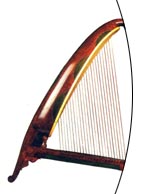Çeng
Çeng
 This
is one of the instruments included under the category of ‘open harps.’ These are
divided in turn into ‘bow’ and ‘angled’ harps. The çeng belongs to the second
category. In open harps the strings are stretched between the peg box and the
resonator. There is nothing in front of the longest (and deepest) string. In
closed harps, there is a third part that joins the two sides of the resonator
and the peg box which form an angle. As in modern harps, this part is found in
front of and parallel to the longest string.
This
is one of the instruments included under the category of ‘open harps.’ These are
divided in turn into ‘bow’ and ‘angled’ harps. The çeng belongs to the second
category. In open harps the strings are stretched between the peg box and the
resonator. There is nothing in front of the longest (and deepest) string. In
closed harps, there is a third part that joins the two sides of the resonator
and the peg box which form an angle. As in modern harps, this part is found in
front of and parallel to the longest string.
The pegs and resonator are made from the same piece of wood in bow harps,
which are the most primitive form and whixh the strings are stretched between
those two. The earliest known examples, from the Anatolian, Mesopotamian and
Egyptian civilisations, date back to around 1,000 B.C. Angled harps began to be
used in the same areas but at a later date. These have an angle of some 70
degrees between the flat or curved resonator and the pegs. Some pictures of
harps reveal a degree of up to 90 degrees.
Angled harps were used for thousands of years by Anatolian, Mesopotamian and
Egyptian civilisations, and the latest to emerge was the Ottoman çeng. It was
used up until the last quarter of the 17th century, but due to the difficulties
in playing, carrying and tuning it, and the increasing popularity of such
instruments as the tambur and santur, it slowly disappeared from the stage of
history.